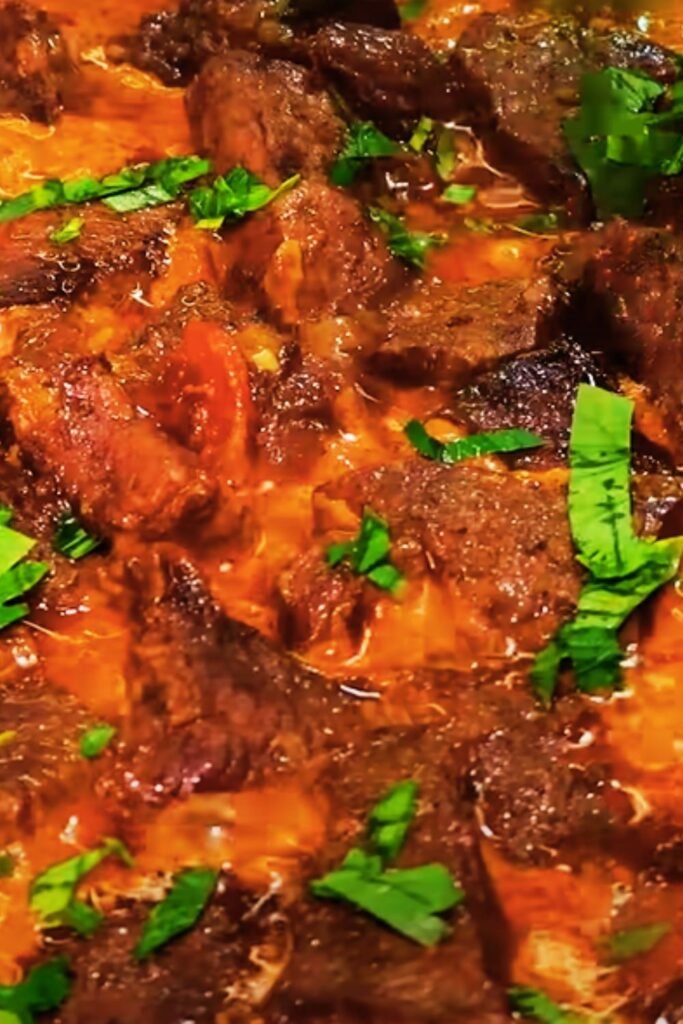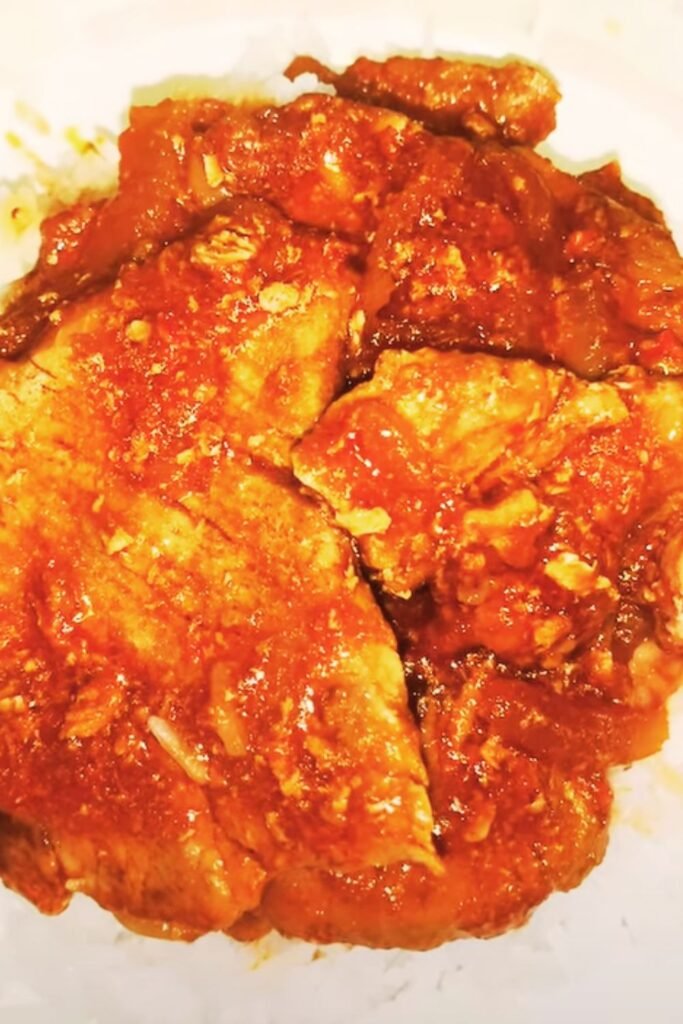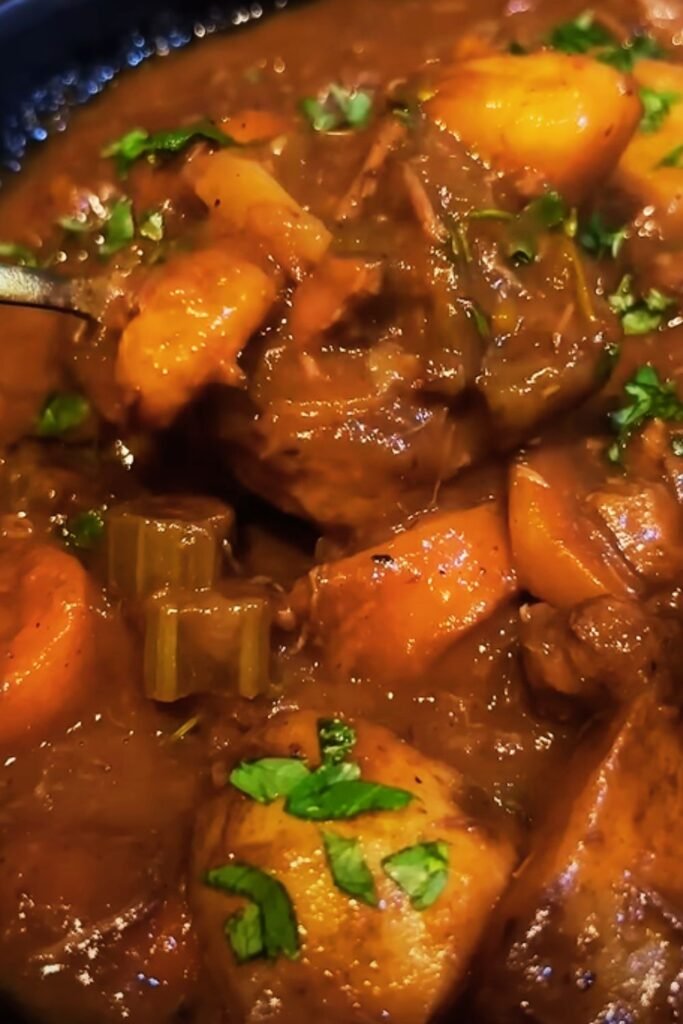There’s something magical about dishes that have been passed down through generations, carrying with them stories, traditions, and the unmistakable taste of home. As someone who grew up surrounded by Portuguese cooking, I can tell you that Caçoila (pronounced ka-soy-la) is one of those special recipes that defines Portuguese comfort food. This tender, aromatic stewed beef simmered in a rich blend of wine, garlic, and spices captures the essence of Portuguese cuisine – simple ingredients transformed through patience and love into something extraordinary.
The Story Behind Caçoila
My first memory of Caçoila takes me back to my grandmother’s kitchen, where the enticing aroma would fill the house hours before dinner. In Portugal, particularly in the Azores islands, Caçoila has been a staple for centuries, traditionally prepared for special gatherings and celebrations.
What makes this dish so special isn’t just its incredible flavor but also its versatility. In Portugal, you’ll find regional variations that reflect local traditions and available ingredients. Some households prepare it with pork (sometimes called “Caçoila de Porco”), while others, like mine, remain loyal to the beef version that’s popular in many Portuguese-American communities.
The Secret to Authentic Caçoila
The beauty of Caçoila lies in its simplicity and the slow cooking process that allows the meat to become incredibly tender while absorbing all the wonderful flavors. While modern shortcuts exist, I’ve found that honoring the traditional slow-cooking method yields the most authentic results.
Let me share my family’s treasured recipe with you, with a few personal touches I’ve added over the years.
Ingredients
For the Marinade:
- 3 pounds chuck roast, cut into 2-inch cubes
- 1 cup red wine vinegar
- 6 cloves garlic, minced
- 2 bay leaves
- 1 tablespoon paprika (sweet, not smoked)
- 1 teaspoon ground cinnamon
- 1/2 teaspoon ground cloves
- 1 teaspoon salt
- 1/2 teaspoon black pepper
- 1 large onion, thinly sliced
- 1/4 cup olive oil
For Cooking:
- 2 tablespoons olive oil
- 1 can (15 oz) tomato sauce
- 1 cup beef broth
- 1 tablespoon brown sugar (optional – my grandmother’s secret touch)
- 2 tablespoons fresh parsley, chopped
Equipment
This dish traditionally requires a clay pot called a “caçoila” (which is where the dish gets its name), but any heavy-bottomed pot or Dutch oven will work beautifully. Here’s what you’ll need:
- Dutch oven or heavy pot with lid
- Mixing bowl for marinade
- Sharp knife
- Cutting board
- Measuring cups and spoons
- Wooden spoon

Preparation Method
Step 1: Prepare the Marinade
- In a large glass or ceramic bowl, combine the vinegar, minced garlic, bay leaves, paprika, cinnamon, cloves, salt, pepper, sliced onions, and olive oil.
- Add the cubed beef to the marinade, ensuring each piece is well-coated.
- Cover and refrigerate for at least 8 hours, preferably overnight. This is crucial for developing those deep flavors!
Step 2: Cook the Caçoila
- Remove the meat from the marinade, reserving the liquid and the onions.
- Heat 2 tablespoons of olive oil in your Dutch oven over medium-high heat.
- Working in batches, brown the meat on all sides (about 2-3 minutes per batch). Don’t overcrowd the pot!
- Once all meat is browned, return it all to the pot along with the reserved marinade liquid and onions.
- Add the tomato sauce and beef broth, stirring gently to combine.
- Bring to a simmer, then reduce heat to very low.
- Cover and let it cook slowly for 2.5-3 hours, stirring occasionally, until the meat is fork-tender.
- During the last 30 minutes of cooking, if using, add the brown sugar to balance the acidity.
- Taste and adjust seasoning if needed.
- Sprinkle with fresh parsley before serving.
Traditional Serving Suggestions
In Portugal, Caçoila is often served in a few different ways:
As a Main Dish
Serve with boiled or roasted potatoes and a simple green salad. The potatoes are perfect for soaking up the flavorful sauce.
As a Sandwich (My Favorite)
In Portuguese-American communities, especially in Massachusetts and Rhode Island, Caçoila is often served on a Portuguese pop (papo seco) or a crusty roll. The bread soaks up the juices beautifully, making it a messy but incredibly satisfying meal.
With Rice and Vegetables
A bed of white rice makes an excellent canvas for the rich, savory stew. Add a side of sautéed greens like kale or collards for a complete meal.

Nutritional Information
For those watching their nutritional intake, here’s an approximate breakdown per serving (assuming 8 servings):
| Nutrient | Amount |
|---|---|
| Calories | 385 |
| Protein | 29g |
| Fat | 24g |
| Carbohydrates | 8g |
| Fiber | 1.5g |
| Sodium | 520mg |
Tips for the Perfect Caçoila
Throughout my years of making this dish, I’ve learned a few things that make a significant difference:
- Choose the right cut: Chuck roast is ideal as it has enough fat to become tender and flavorful during the long cooking process.
- Don’t rush the marinating: The longer you marinate, the more flavor develops. I’ve gone up to 24 hours with spectacular results.
- Temperature matters: Keep the cooking temperature very low. Caçoila should never boil—just a gentle simmer is all you need.
- Better the next day: Like many stews, Caçoila tastes even better the next day after the flavors have had time to meld together. If you’re planning for a special occasion, consider making it a day ahead.
- Freeze with confidence: This dish freezes beautifully for up to 3 months. I often make a double batch specifically to freeze half for future easy meals.
Variations and Regional Differences
Portuguese cuisine has many regional variations, and Caçoila is no exception:
Azorean Style
In the Azores, particularly on São Miguel island, Caçoila is often made with pork and cooked in a traditional clay pot underground using volcanic heat—a method called “Cozido das Furnas.”
Madeira Variation
In Madeira, they sometimes add local wine instead of vinegar and incorporate more tropical spices.
Portuguese-American Adaptations
In communities across Massachusetts, Rhode Island, and other areas with large Portuguese populations, Caçoila has evolved to incorporate locally available ingredients while maintaining its authentic core.

The History Behind the Dish
Caçoila reflects Portugal’s rich culinary history, which has been influenced by global exploration and trade. The use of cinnamon and cloves—spices that weren’t native to Europe—showcases Portugal’s historical role in the spice trade during the Age of Discovery.
The dish was traditionally prepared for festive occasions and celebrations. In many villages, it would be cooked in large quantities for community gatherings, religious feasts, and family celebrations. During traditional Portuguese festivals, large clay pots of Caçoila would simmer for hours, filling the air with their mouthwatering aroma.
Modern Adaptations
While I’m a traditionalist at heart when it comes to Caçoila, I recognize that modern lifestyles sometimes require adaptations. Here are some alternatives that still honor the essence of the dish:
Slow Cooker Method
After marinating the meat, transfer everything to a slow cooker and cook on low for 8 hours. This is perfect for busy days when you can’t monitor a pot on the stove.
Instant Pot Variation
For those times when you’re craving Caçoila but didn’t plan ahead:
- Use the sauté function to brown the meat.
- Add all ingredients (you can shorten the marinating time to 2 hours in a pinch).
- Cook on high pressure for 45 minutes with a natural pressure release.
- While this isn’t traditional, the results are surprisingly good for a quick version.
Healthier Modifications
- Trim excess fat from the meat before marinating.
- Use less oil in the cooking process.
- Incorporate more vegetables like carrots and bell peppers.
- Use low-sodium broth to reduce salt content.
A Personal Note
I believe that traditional recipes like Caçoila are about more than just food—they’re about preserving culture and creating connections. When I make this dish for friends who haven’t experienced Portuguese cuisine before, their eyes light up at the first bite. That moment of sharing something meaningful from my heritage is priceless.
Each time I prepare this dish, I feel connected to generations of Portuguese cooks who came before me. The rhythmic chopping of ingredients, the patient waiting as the stew simmers, and the familiar aromas that fill my kitchen transport me back to my grandmother’s home and the countless family gatherings centered around food and love.
Frequently Asked Questions
Q: Can I use a different cut of beef for Caçoila?
While chuck roast is traditional and ideal because of its fat content and how it breaks down during slow cooking, you can substitute with brisket or bottom round roast. Just be aware that leaner cuts may not become quite as tender or flavorful.
Q: Is it absolutely necessary to marinate the meat overnight?
For authentic flavor, I strongly recommend marinating for at least 8 hours. However, if you’re in a pinch, even 4 hours will impart some flavor. The difference is noticeable though—longer marination results in more depth of flavor and tenderness.
Q: Can I make this dish ahead of time for a party?
Absolutely! In fact, I recommend it. Make the Caçoila 1-2 days before your event and refrigerate it. Reheat slowly on the stovetop before serving. The flavors actually develop and improve with time.
Q: My sauce seems too thin. How can I thicken it?
If your sauce is thinner than you’d like, you have a few options:
- Continue simmering with the lid off to reduce the liquid.
- Mix 1 tablespoon of cornstarch with 2 tablespoons of cold water and stir this slurry into the simmering stew.
- Mash some of the potatoes (if serving with them) and stir them into the sauce.
Q: What’s the best way to reheat leftover Caçoila?
For best results, reheat slowly on the stovetop over medium-low heat, stirring occasionally. Add a splash of beef broth if the sauce has thickened too much during storage. Avoid microwave reheating if possible, as it can make the meat tough.
Q: Is this dish spicy?
Traditional Caçoila is aromatic and flavorful but not spicy-hot. The paprika adds color and mild flavor rather than heat. If you prefer a spicier version, you can add a pinch of crushed red pepper flakes to the marinade.
Q: Can I freeze Caçoila?
Yes! Cool the Caçoila completely, then transfer to freezer-safe containers, leaving some room for expansion. It freezes well for up to 3 months. Thaw overnight in the refrigerator before reheating.
Seasonal Serving Suggestions
Caçoila is wonderful year-round, but I find different serving styles work better in different seasons:
Winter Comfort
Serve hot Caçoila with mashed potatoes and roasted root vegetables for a hearty meal that warms from the inside out.
Summer Gatherings
For summer entertaining, I love serving Caçoila as mini sandwiches (sliders) with a crisp side salad or traditional Portuguese tomato and onion salad.
Fall Harvest
Pair with roasted butternut squash and Brussels sprouts for a perfect autumn dinner.
Spring Freshness
Lighten things up by serving smaller portions with plenty of fresh steamed spring vegetables and herbs.
Final Thoughts
Caçoila isn’t just a recipe—it’s a tradition, a connection to Portugal’s rich culinary heritage, and for many Portuguese families like mine, a taste of home. Whether you have Portuguese ancestry or you’re simply an adventurous food lover, I hope this recipe brings as much joy to your table as it has to mine over the years.
I find something deeply satisfying about maintaining these culinary traditions in our fast-paced world. When I set aside an afternoon to prepare Caçoila, moving slowly and deliberately through each step of the process, I’m not just making dinner—I’m participating in a ritual that connects me to my roots.
The next time you’re looking for a dish that combines incredible flavor with rich cultural history, I hope you’ll give this Caçoila recipe a try. And as we say in Portuguese before a meal: “Bom apetite!”